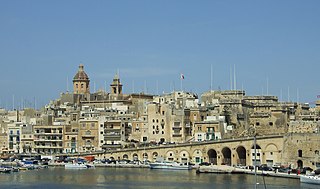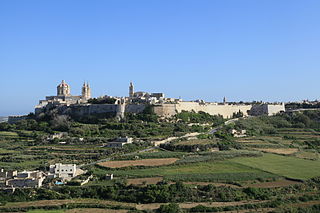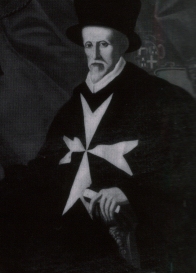Related Research Articles

Nicolas Durand, sieur de Villegaignon, also Villegagnon was a commander of the Knights of Malta, and later a French naval officer who attempted to help the Huguenots in France escape persecution, before turning against them due to Eucharistic disputes.

Birgu, also known by its title Città Vittoriosa, is an old fortified city on the south side of the Grand Harbour in the South Eastern Region of Malta. The city occupies a promontory of land with Fort Saint Angelo at its head and the city of Cospicua at its base. Birgu is ideally situated for safe anchorage, and over time it has developed a very long history with maritime, mercantile and military activities.

Mdina, also known by its Italian epithets Città Vecchia and Città Notabile, is a fortified city in the Northern Region of Malta which served as the island's former capital, from antiquity to the medieval period. The city is still confined within its walls, and has a population of 250.

The Great Siege of Malta occurred in 1565 when the Ottoman Empire attempted to conquer the island of Malta, then held by the Knights Hospitaller. The siege lasted nearly four months, from 18 May to 8 September 1565.
The Lymond Chronicles is a series of six historical novels written by Dorothy Dunnett and first published between 1961 and 1975. Set in mid-16th-century Europe and the Mediterranean area, the series tells the story of a young Scottish nobleman, Francis Crawford of Lymond, from 1547 until 1558.

Fort Saint Elmo is a star fort in Valletta, Malta. It stands on the seaward shore of the Sciberras Peninsula that divides Marsamxett Harbour from Grand Harbour, and commands the entrances to both harbours along with Fort Tigné and Fort Ricasoli. It is best known for its role in the Great Siege of Malta in 1565.

Fort Saint Michael was a small fort in the land front of the city of Senglea, Malta. It was originally built in the 1552 and played a significant role in the Great Siege of Malta of 1565. Following the siege, it was rebuilt as Saint Michael Cavalier, and was completed in 1581. The cavalier was partially demolished in the 20th century, and only a part of its base remains today.

Victory Day is a public holiday celebrated in Malta on 8 September and recalls the end of three historical sieges made on the Maltese archipelago, namely: the Great Siege of Malta by the Ottoman Empire ending in 1565; the Siege of Valletta by the French Blockade ending in 1800; and, the Siege of Malta during the Second World War by the Axis forces ending in 1943.

Marsamxett Harbour, historically also referred to as Marsamuscetto, is a natural harbour on the island of Malta. It is located to the north of the larger Grand Harbour. The harbour is generally more dedicated to leisure use than the Grand Harbour.

The Battle of Djerba took place in May 1560 near the island of Djerba, Tunisia. The Ottomans under Piyale Pasha's command overwhelmed a large joint Christian alliance fleet, composed chiefly of Spanish, Papal, Genoese, Maltese, and Neapolitan forces. The allies lost 27 galleys and some smaller vessels as well as the fortified island of Djerba. This victory marked perhaps the high point of Ottoman power in the Mediterranean Sea.

Fra' Juan de Homedes y Coscón was a Spanish knight of Aragon who served as the 47th Grand Master of the Order of Malta, between 1536 and 1553.

The siege of Tripoli occurred in 1551 when the Ottoman Turks and Barbary pirates besieged and vanquished the Knights of Malta in the Red Castle of Tripoli, modern Libya. The Spanish had established an outpost in Tripoli in 1510, and Charles V remitted it to the Knights in 1530. The siege culminated in a six-day bombardment and the surrender of the city on 15 August.

The Invasion of Gozo took place in July 1551, and was accomplished by the Ottoman Empire against the island of Gozo, following an unsuccessful attempt to conquer nearby Malta on 18 July 1551. It was followed by a victorious campaign with the siege of Tripoli.

Dragut was an Ottoman corsair, naval commander, governor, and noble. Under his command, the Ottoman Empire's maritime power was extended across North Africa. Recognized for his military genius, and as being among "the most dangerous" of corsairs, Dragut has been referred to as "the greatest pirate warrior of all time", "undoubtedly the most able of all the Turkish leaders", and "the uncrowned king of the Mediterranean". He was nicknamed "the Drawn Sword of Islam". He was described by a French admiral as "a living chart of the Mediterranean, skillful enough on land to be compared to the finest generals of the time" and that "no one was more worthy than he to bear the name of king". Hayreddin Barbarossa, who was his mentor, stated that Dragut was ahead of him "both in fishing and bravery".

Hospitaller Malta, known in Maltese history as the Knights' Period, was a de facto state which existed between 1530 and 1798 when the Mediterranean islands of Malta and Gozo were ruled by the Order of St. John of Jerusalem. It was formally a vassal state of the Kingdom of Sicily, and it came into being when Emperor Charles V granted the islands as well as the city of Tripoli in modern Libya to the Order, following the latter's loss of Rhodes in 1522. Hospitaller Tripoli was lost to the Ottoman Empire in 1551, but an Ottoman attempt to take Malta in 1565 failed.

Fra' Jean "Parisot" de (la) Valette was a French nobleman and 49th Grand Master of the Order of Malta, from 21 August 1557 to his death in 1568. As a Knight Hospitaller, joining the order in the Langue de Provence, he fought with distinction against the Turks at Rhodes. As Grand Master, Valette became the Order's hero and most illustrious leader, commanding the resistance against the Ottomans at the Great Siege of Malta in 1565, sometimes regarded as one of the greatest sieges of all time.

The Chapel of St Anne is a Roman Catholic chapel located in Fort Saint Elmo in Valletta, Malta. Its existence was first documented in the late 15th century, and it was incorporated into the fort when the latter was constructed by the Order of St John in the mid-16th century. The chapel's present state dates back to the mid-17th century.

Tripoli, today the capital city of Libya, was a presidio of the Spanish Empire in North Africa between 1510 and 1530. The city was captured by Spanish forces in July 1510, and for the next two decades it was administered as an outpost which fell under the jurisdiction of the Spanish Viceroy of Sicily. The city was granted as a fief to the Knights Hospitaller in 1530, and the latter ruled the city until 1551.

Tripoli, today the capital city of Libya, was ruled by the Knights Hospitaller between 1530 and 1551. The city had been under Spanish rule for two decades before it was granted as a fief to the Hospitallers in 1530 along with the islands of Malta and Gozo. The Hospitallers found it difficult to control both the city and the islands, and at times they proposed to either move their headquarters to Tripoli or to abandon and raze the city. Hospitaller rule over Tripoli ended in 1551 when the city was captured by the Ottoman Empire following a siege.
References
- ↑ https://core.ac.uk/download/pdf/100403.pdf [ bare URL PDF ]
- ↑ "Knights, Memory, and the Siege of 1565: An Exhibition on the 450th Anniversary of the Great Siege of Malta". calameo.com.
- ↑ "Website for 'Pirates of Christ' novel".
- ↑ "1565: St. Elmo's Pay – The Great Siege of Malta". BoardGameGeek. Retrieved 2024-10-05.